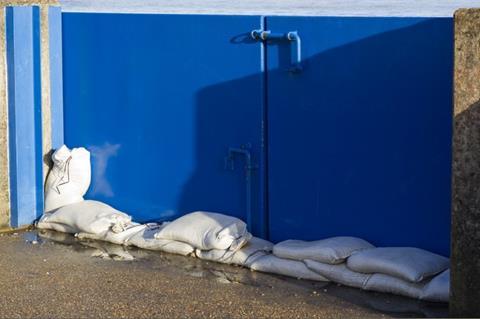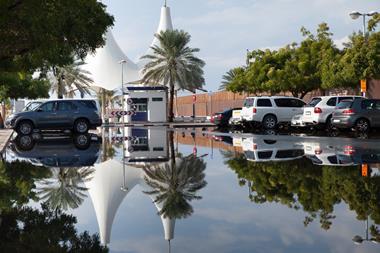Preventative measures will reduce Central European flood cost, says Moody’s. Here are the steps that impacted businesses should take now
Flooding in Central and Eastern Europe calls into memory some of the most destructive, widespread, and costliest flood events affecting this region, Steffi Uhlemann-Elmer, director, product management, Moody has written in a note on the ongoing events.
Previous floods in 2013, 2002, 1997, and as far back as 1954 are all known to have been associated with a so-called Vb (Five-B) weather pattern, she emphasised.

Economic losses for these events have, if trended to today’s values surpassed €10bn per each event, with the 2002 flooding reaching €37bn, Uhlemann-Elmer said, citing EEA data, trended to 2022 values.
This record was only recently broken by the deadly flood events in central Europe in 2021, another summer flood event, which reached well above €40bn in economic loss, she observed.
Typical Vb track
The current event follows the typical Vb track; a low-pressure system that typically evolves south of the Alps, and slowly moves on a track further east and northwards, she explianed.
“The system moves counterclockwise in a wide arc and circulates warm and very moist air from the Mediterranean to the north where it meets cooler air masses on a trajectory south and additionally gets pressed against the mountain ranges in its way,” Uhlemann-Elmer said.
“This results in persistent and widespread heavy precipitation in the river basins of the Odra, Elbe, and Danube with many violent flash floods in their mountainous tributaries and headwater catchments,” she added.
Dampened losses
Forecasting and preventative measures put in place will reduce the scale of economic – and insured – losses, compared to some previous events, she suggested.
“With the weather pattern having been forecast for over a week, warning chains had been activated, and preventive measures such as the release of water from dams and catastrophe response plans to coordinate efforts across states, regions, and communities have been activated,” Uhlemann-Elmer said.
These measures will make a substantial difference in the loss outcome compared to the 1997 and 2002 events in particular, she explained.
“However, remote and mountainous regions are going to suffer the most, and many areas have already reported major damage from the ongoing event. Further, the ability of flood defences to withstand the flood wave as it propagates down the major rivers, the final height of the flood peak, and its duration are major determinants of the total cost,” she said.
Catastrophe zone
Rainfall totals of more than 100 millimeters per day have been widely observed, with over 300 millimeters in three days for locations in the Czechia and Austria.
The Lower Austria Province, with a population of about 1.7m people, in northeast Austria, has been declared a catastrophe zone, Uhlemann-Elmer reported, with more than 1,000 houses have been evacuated in Lower Austria, with three fatalities.
“Over the next few days, the area of low pressure is expected to move slowly south towards the Mediterranean Sea, which is forecast to bring additional rainfall to Italy, Croatia, and Greece, while rainfall is expected to gradually ease in the previously impacted areas.
“Flooding is expected to continue for the rest of this week, with flood warnings across Czechia and Germany,” Uhlemann-Elmer added.
How businesses can tackle flood threats
Klaus Peter Roehler, member of the board of management of Allianz SE says: “We believe that extreme weather events will increase in intensity and frequency as a result of climate change.
“We therefore need a comprehensive concept against natural hazards that is based on three building blocks: prevention and protective measures to adapt to the effects of climate change, insurance cover calculated on a risk-adjusted basis, and state support in the event of extreme disasters.
“Damage to buildings can be prevented or at least reduced if we increase social risk awareness and implement comprehensive prevention and protection measures against flooding. These include higher and stronger dams, but also construction bans in flood areas, a requirement for water-resistant building materials and better flood protection systems.”
What to do when a flood hits
Businesses in areas prone to flooding should ensure that they have a Flood Emergency Response Plan (FERP). This should be tested through drills and updated regularly.
FM Global says that as soon as possible after the flood, the ERT and other personnel should begin salvage procedures, beginning with the immediate drying of equipment and dehumidifying areas of critical importance.
It also suggests businesses follow these steps:
- Keep fire protection systems in service. This is vital because cleanup can result in the buildup of large piles of combustible material.
- Return any impaired fire protection systems, including alarm notification systems, to service promptly.
- Test any system potentially affected by the flood.
- Conduct all cutting and welding repairs using FM Global’s Hot Work Permit System to prevent fire.
- Assess the actual impact, determine needs and initiate planned cleanup, repair and business-resumption services.
- Check flooded buildings for structural stability before starting cleanup inside.
- Check for spilled flammable liquid, contaminants, etc., and eliminate them before other work begins.
- Remove standing water from the facility.
- Clean and dry equipment, giving attention to the most vital or susceptible pieces first.
- Check, clean and test all electrical distribution equipment and system components exposed to flood water or humidity.
- Dehumidify damp areas and dry wet insulation and building material.
- Remove flood debris from the facility and separate wet material.
- Develop a Flood Emergency Response Plan now-if you don’t have one in place.










No comments yet